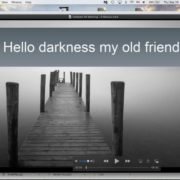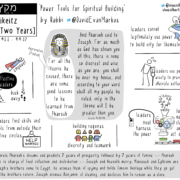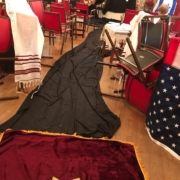The Mishkan’s Next Digital (R)Evolution

Reb Zalman Memorial Shabbaton 2020
June 13, 2020 • 21 Sivan 5780
מה נורא המקום הזה
|
How awesome is this body! How awesome is this place! |
How awesome is this journey Through time and space. |
(Chant by Rav Kohenet Taya Mâ Shere.)
Shabbat shalom to all of us together במקום נורא הזה / in this awesome place, to honor Reb Zalman’s living legacy. Wherever you are, our Zoom spiritual link is part of what Zalman imagined decades ago. This spiritual space is what today is about. We’re coming to know digital not as a mere filler for what’s real, but as a real vibrant מקום of its own. Today is about what that might mean, and what it may ask of us.
Zalman might start us with a paradox about what we know and how we know it. Zalman famously put it this way:
I start looking ahead … and suddenly I find [that] I am looking through the rearview mirror. When you ask, “What would the future look like?,” I go into a nostalgic past, a romanticized past, and then go into a tribal thing, and think for a moment, “It would look like that.” But it’s not going to look like that. We are on the verge of breakthroughs that are so immense that we can hardly imagine them. But it pays to imagine them, and it pays to … figure [them] out.
Zalman’s rearview metaphor is about humility. Maybe Zalman wouldn’t call himself modest – not the guy who urged us all to melitz yosher, spiritual intercession with holy chutzpah. Still, there’s humility to know that the future won’t look how we imagine it. Our history refracts future-questing vision so insidiously that usually we end up seeing the rear view of experience as some great vista up ahead.
Thus Torah this week calls Moses האיש עניו מאוד מכל האדם אשר אל פני האדמה / “the earth’s most humble person” (Num. 12:3). Only such a person could see divinity באספקלריה מאירה / by a clear lens (B. Yevamot 49b) rather than hindsight. Even more, in this week of Beha’alotecha – which opens with נרות המנורה / the menorah lights of the Mishkan, our first מקום נורא – our haftarah proclaims explicitly what the menorah light means: לא בחיל ולא בכח כי אם ברוחי אמר יהו”ה / “Not by might and not by power but by My spirit, says [God]” (Zach. 4:6). All light that we see is reflected light – rearview in all our vision and willful certainty.
Hence our paradox. If only by anavah, not the might or power of rear-view vision by reflected light, how can we see the future – much less build it?
Zalman had advice on this. Paradigm shifts like the one we’re in now – can anyone deny the tectonic shifts underfoot? – ask both anavah and holy chutzpah, humility and audacity. No, the future won’t look how we envision it, but still we must build that future because people, communities and the planet need it now. So we build what we see, and what gets built itself will end up different. Fine!
So it’s in both chutzpah and anavah that we reach this Zoomosphere moment. There’s no going back: yesterday’s “normal” is history, and mere nostalgia will cheat the future. We must build the future, even if we only see it in the rearview mirror.
Thankfully not everything in the rearview is mere nostalgia. Our hindsight can trace human spiritual history leading to our Zoomosphere, all of us “log[ging] onto God” exactly where we are, as Rachel quoted Zalman last night. We might sense that history as the divine flow Itself, and imagine where that flow is leading. And with some chutzpah, we might tell that story, all of spiritual time from the Beginning, על רגל אחת / “on one foot.” One story in two acts. Ready?
In a Beginning, the One created space and time. Eternal sacred space called Eden ejected humanity; space itself re-booted with a flood of new life. The One told Avram: lech lecha from ancestral space “to a land I’ll show you” (Gen. 12:1). Avram raised sacred markers along the way. Yitzchak “went out to talk [with God] in the field” (Gen. 24:68). Jacob dreamed an angelic ladder highway: מה נורא המקום הזה / “Right here is the House of God” (Gen. 28:18), forgetting that every right here is, too. His sons also missed it: cue centuries of bondage building sacred space for Pharaoh. Freedom! Sand-blind weeks to camp at history’s most famous sacred place nobody can find. Two tablets! Oops; two more tablets! Build a Mishkan, complete with menorah. Light it up and follow the cloud. (That’s this week.) Too afraid to go where I’ll show you? In 40 years, a next generation will try again. Enter the Land. Build a Temple, with menorah. Light it up! Exile 70 years by the waters of Babylon, where we sat and wept remembering Zion. Go back. Build a second Temple, with menorah. Light it up! Exile. End of Act One.
Intermission: God won’t be fixed in any one place. The Sfat Emet (1846-1905) taught that we are God’s menorah, so “the essence of the Mishkan and Temple is that it’s in everyone. That’s the point of ועשו לי מקדש שוכנתי בתוכם / ‘Make Me a Sanctuary that I may dwell in them’ (Ex. 25:8)…. When the Temple stood, all knew that all life came of God,” but this knowledge kept depending on place. So the Temple had to be destroyed to upshift our search for God from the constraining particularity of any place: “With the Mishkan hidden [in us], God’s presence can be found everywhere.”
Act Two: Sacred space on the go. The Mishkan’s table became every Shabbat table, learning centers like Sura and Pumbedita, Talmud, shuls, printing presses, books, liturgies, “correct” ways carved by power and custom. Trade routes, living most anywhere but hearts still in the East. Exile and inquisition. Not so much the East: go West. Enlightenment! Liberty? Assimilation! Denominations? Fractures! World wars? Israel! The nuclear age, the digital age, de-centering of every kind of institution, now a global pandemic bringing us together by separating us. “With the Mishkan hidden, God’s presence can be found everywhere.” How about on Zoom?
Rearview vision is good for seeing patterns. The pattern seems to be that, all along, God used examples of sacred space to teach us cosmology. Eden, Avraham’s matzevot, Yitzchak in the field, Jacob’s ladder place, Egyptian temples, Sinai, mobile Mishkan, two Temples, post-exile Shabbat tables, houses of learning, shuls – each sacred place was an example to show that מלא כל הארץ כבודו / “the whole Earth is full of God’s glory” (Isaiah 6:3). But we confused example for essence; as Zalman put it, we “confused the pointer for the point.” So pointers kept coming. But rather than get the point, grief aroused nostalgia. In Zalman’s words from 1993, we venerated each pointer as a holy “relic” rather than a “catalyst for the future.”
And again today. Many grieve Jewish institutions failing by the day. Many grieve physical shuls as the pandemic exiles us to our homes. Now we must make sacred space in our homes – it’s here, or nowhere. And that was the point all along.
Today’s exile to our homes is no ordinary exile. It’s an inzile: it turns us in, and it turns us inward. We’re roused to seek the very thing for which our inzile most cues our yearning – real connection. And for once, the whole world can start to see the same things. Now all humanity can experience each place, each home, that way.
In wise words inscribed on rearview mirrors: “Things are closer than they appear.”
Just as the menorah light lifts divine spirit over human might, digital means divine connection everywhere – or, at least, it can. It’s not automatic: it asks us to transform. We’re only starting to sense those transformations, and they won’t look quite like what we see. But anavah balances with chutzpah: we must build our Digital Mishkan. After kiddush, we’ll explore more about how, including some ideas around bending time if we’re not in the same time zone, and technical points like digital infrastructure, skillful means and a sacred ZoomCorps so nobody’s left behind.
Beyond the technical, Zalman urged “backward compatibility” when possible. Dig deep, because our ancestors probably laid some foundation stone to anchor us. And they did: 1,700 years ago, Midrash Tehillim 4:11 ascribed these words to God:
|
אמר הקב”ה: אני אמרתי כשאתה מתפלל, התפלל בבית הכנסת שבעירך. ואם אתה אינך יכול לילך בבית הכנסת שבעירך, התפלל בתוך ביתך. ואם אין אתה יכול לילך להתפלל, תתפלל על מטתך. ואם אין את יכול לדבר, הרהר בלבך. |
God said, “I told you that when you pray, pray in a Beit Knesset in your community. And if you can’t go to a Beit Knesset in your community, pray in your house. And if you can’t go to pray, pray in your bed. And if you can’t speak, meditate in your heart.” |
How wise! A synagogue always was called a Beit Knesset, a place of entering. It’s about entering another state and doing so together – not physically going. Yet we’re still to “go” somewhere, even if we stay in our “house.” So it’s about entering, by making an intentional shift where we physically are.
That shift depends on each soul, as it must now because we’re each in our own homes. Inzile means that we can’t totally outsource to the rabbi, cantor, teacher, guru, yoga instructor or anyone outside. We never could: only we can experience our space as sacred, but circumstances brings that truth close to home, at home.
Suddenly the only table in the Mishkan that can be sacred is our table, in our home. If the Mishkan is to have a table sacred for you, only you can make it so. It’s a radical, profound empowerment: it always was so, but now it hits home, at home.
If a Zoom connection is to be sacred for you, only you can make it so. Skillful means will help – it’s still a shared medium – but it’s on you to “go” to sacred space by making intentional shifts in the sacred space that is our home. We’ll harness the senses of embodiment. We’ll take on ourselves to set our spaces in ways that aren’t routine; to dress for spiritual experience; to silence distracting devices like TVs and phones except for emergencies; to wash ritually before spiritual experience online.
That’s Assiyah, physicality. In Yetzirah, we’ll accustom emotionally to open by new cues, new tenderizers. We’re still carbon-based creatures: we evolved to feel, we learned to feel, by feeling other people first. Our mirror neurons sympathetically resonate with others. It’s why the physicality of collective gathering opens us emotionally, and it still can. Our neuroplasticity, evolutionary capacity to rewire, will learn to take in others and cue us to feel deeply together online – but it’ll take time and focus. It’s why we checked in with faces and bodies during the service.
And over time, we’ll learn how to meet new people digitally. It can feel easier to go deep online if we already know someone, if digital connection activates the felt sense of pre-existing physical relationships. That’s good, but can’t be the only way. As we adapt, digital will feel less like a poor substitute for “real life.” Digital is real, with real emotions, real spirituality, real prayer, real community, real tzedakah, real voting, real political campaigns. We’ll get there.
Until then, this time of adjustment asks us to be gentle with each other and ourselves. Until digital feels fully real, people may feel lonely. If digital doesn’t hit the spot, we may feel even more isolated for all our so-called digital connectivity. We may mourn “normal”: that too is our inzile, our turning inward. These emotions will teach us if we let them, lest we become calcified and brittle. If we let them, our inner defenses to the tumult of this time will ease and new inner landscapes will open. Until then, let’s be gentle, take extra time with each other, and take it slow.
In Briyah, in thought, Zalman was right: we see the future in the rearview mirror. However sure our vision, it won’t “look like that. We are on the verge of breakthroughs that are so immense that we can hardly imagine them. But it pays to imagine them, and it pays to … figure [them] out.” That’s part of what we’re doing here – sandboxing, trying, testing, adjusting and trying again.
Wise spiritual building isn’t like how I cook pasta – throw it at the wall and see if it sticks. Serendipity, yes, but not avant garde to be different for its own sake. It’s not doing what we want just because we want it, without the healthy gevurah of standards, ethics and external accountability for them. The collectivity and stakes of this moment, for the Jewish future and the whole world, ask better than that.
Digital is good for that. Digital allows collaboration across most every divide in ways that can hasten the necessary re-ordering of systems. It allows fast feedback, democratized, from everyone. It generates more data and helps us ask for it and use it. It will reward people, groups and systems that do. And that is good: insist on it.
In Atzilut, in essence, divine cosmology is as it’s always been: מלא כל הארץ כבודו / “the whole Earth is full of God’s glory.” Finally, finally, our inzile might teach us that every place is sacred space. “With the Mishkan hidden [within us], God’s presence can be found everywhere.” The Mishkan is where you are. It always was. The menorah is within you. It always was. Light it up, and follow the cloud. It will lead you if you let it. It will lead us if we let it. It always has. It always will.
מה נורא המקום הזה
|
How awesome is this body! How awesome is this place! |
How awesome is this journey Through time and space. |
Offered as a keynote teaching at “An Emerging Judaism: A Global Digital Convening,” the Digital Reb Zalman Memorial Shabbaton organized by Havurah Shir Hadash in Ashland, Oregon. Designed to dovetail with R’ Rachel’s keynote, Being Real: Digital Edition.

By Rabbi David Markus.








